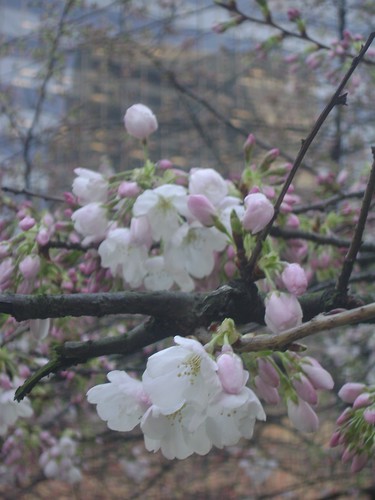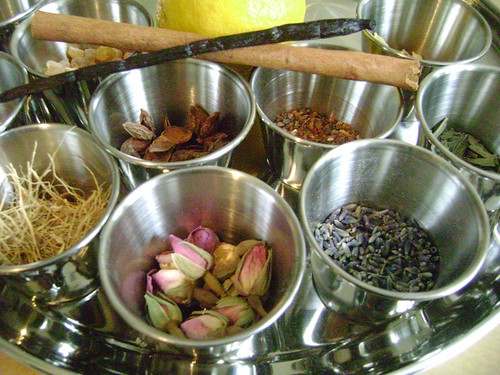Hanami Perfume: Presentation (Creation, Materials, Structure...) and Reflection
The focus was more on the materials themselves, and we went deeper into talking about each note, sharing impressions, and me explaining a bit about each raw material.
Bakul attar: Traditional Indian attar, bakul tree flowers are distilled into a base (carrier) of sandalwood oil. This attar smells mostly of sandalwood to me.
Vetiver from Haiti: Essential oil of rootlets from this tropical grass. The Haitian variety has a very light, almost citrusy and tart character. It feels more moist or wet than others.
Siamwood: Hardwood that is used to make coffins... Has a very similar scent to Himalayan cedarwood - transparent, clean, ethereal.
Cabreuva: Hardwood from South America. Used for making furniture. Extremely hard and has a scent that is flowery and mostly water-like.
Copaiba Balsam: Steam distilled from this South American balsam (pathological secretion from a tree or a shrub), it has a very light vanillic note, yet more on the dry clean and slightly watery side. It's a top note but possesses incredible fixative qualities.
Tonka Bean: High coumarin content from these beans that grow on this South American legume tree is what gives it its distinct almond bark, caramel and vanilla odour. One of the best fixaties as well and is what gives the "sakura accord" its cherry-like bittersweetness.
Vanilla CO2: Molecular distillation from vanilla beans gives a milder character, sweeter and less dark in both appearance and scent. It has less of the woodsy character of vanilla absolute as well.
Cassie Absolute: A type of mimosa, with wet woods, violet and leathery nuances. Really gives Hanami its metallic urban edge.
Violet Leaf Absolute: Like cucumber, crushed leaves and powder. Another contributer to the cool "wetness" of Hanami.
Pink Lotus: Dark and sweet, exotic, narcotic floral with some of animalic decaying murkiness of the water where it grows (it has to be harvested while immersing in them!) and a little powdery too.
Magnolia (White): Tree native to Asia and we see a lot of it here in Vancouver in white and in different shades of pink. The white magnolia is fruity, light and peachy. It gives the Sakura accord its lightheartedness and the sweet gourmand feel.
Oleander: Subtle and powdery as well. It's from a plant native to the Mediterranean region, where it grows mostly in stream and river banks. The branches and leaves exude a poisonous milk-like substance when broken off. It works as part of the heart notes in Hanami, giving it a soft oily-woody and pollen-like character along with the frangipanni and mimosa.
Tuberose: There is a lot to be said about tuberose, one of the most alluring floral notes in perfumery. This flower is related to narcissus, native to Mexico, and intensifies after it is picked, and releases more scent after nightfall. The scent can range between powdery and even a little green, to buttery and milky and all the way to intensely heady and even with medicinal camphoreous and with a lot of wintergreen-like(from methyl salicylate) notes. I used one that is soft and creamy as part of the sakura accord as well.
Frangipanni: Also known as plumeria. This tropical flower has a nectar like scent in real life. The absolute is more on the creamy, powdery and oily side. It gives Hanami an almost aldehydic softness and a little bit of green quality as well.
Mimosa: Flower that grows on bushes from the legume family, native to Australia but has become an invasive species in Europe and the Middle East. It has a light, cucumbery, powdery, watery-woody character. Gives these wet wood qualities at the top notes for Hanami, and also gives it a nice floral top note, with that pollen-filled air touch.
Rosewood: Another South American hardwood, native to Brazil. Use to make furniture and jewelry boxes, etc. It has a lot of linalol in it, which gives it its floral (supposedly rosy) woody character. It gives any perfume a lift and in Hanami it's another layer in the floral-woody theme that is recurring throughout the different layers - top, heart, base.
Touches (scent strips) with Sakura accord, originally uploaded by Ayala Moriel.
The guests also experimented with combining scent strips of different materials together to experience the separate accords the make Hanami what it is. We built the perfume base to top with the metallic wet wood urban base accord (Haitian vetiver - cassie absolute - siamwood - Bakul attar); the sakura accord at the heart (tuberose - magnolia - pink lotus - tonka bean) and the other heart notes and top notes that make Hanami the unique creature that it is, layering petals and pollen over wet woods and metallic cement landscapes to create something that smells like sakuramochi and ume blossoms in Vancouver.

Sakura & Highrise, originally uploaded by Ayala Moriel.
Reflection:
It's all part of my world now.
Memories from two years ago when I created Hanami and worn it for the first time under the cherry blossoms an the rain that went on and on for almost two months (because it got really cold in the middle of the spring, which curiously preserved the blossoms), and than last year again, reminiscing about it in the first heat wave of the year in LA.
I hope this year Hanami perfume will turn to symbolize for me not giving up on beauty and perfume in particular, even when facing less than agreeable situations. I guess for me this perfume has become my internal samurai warrior that fights anguish whenever it sees it. Even if it turns it a little melancholy inside... It just makes it more beautiful and have more depth.





